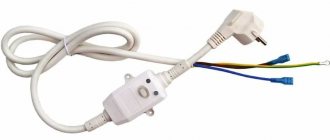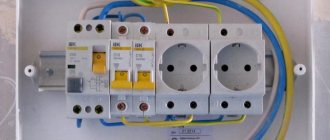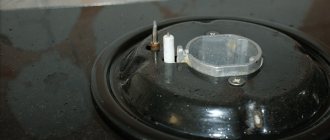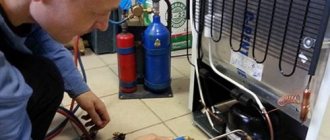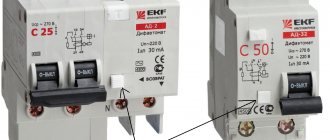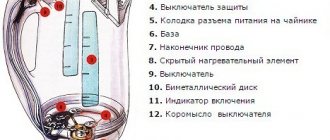If the circuit breaker in the panel is knocked out, then only two reasonable explanations can be given for this: there is a short circuit somewhere or there is an overload in the home network. Of course, eliminating such a problem is urgent, because the life of modern homo sapiens is inextricably linked with electricity at all levels of its activity (or inactivity). To determine the location of the malfunction (the cause of the accident), you need to have an understanding of the situation - to clearly imagine the areas where this could happen.
How does an RCD work?
The operation of an RCD is based on a comparison of currents flowing through the phase and neutral conductors. If they are equal, the device operates normally and passes power to the apartment. If they differ, it means there is a problem somewhere. The RCD cuts off the voltage on the protected line.
Operating principle of the residual current device
The problem means a condition when the currents in the phase and neutral conductors are unequal. To compare these indicators, a special differential transformer is provided in the RCD. Its primary windings are phase and neutral wires, through which current enters the apartment. They are included in antiphase. At the same currents, the windings create magnetic fluxes equal in magnitude but opposite in direction. Their geometric sum is zero. With unequal currents, the magnetic fluxes are different and induce an EMF on the secondary winding of the transformer. The secondary signal goes to the circuit controller, and from it to the actuator - an electromagnetic relay. It disconnects the output L terminal of the RCD from the input terminal.
What you need to know to identify faults
Figuratively, the operation of a protective shutdown device can be compared to a swimming pool, into which water flows through one pipe and leaves from the other. There are meters on both pipes and the job of the RCD is to monitor the equal amount of incoming and outgoing water. With electric current everything happens in much the same way. Each electrical circuit, by definition, is closed - current “enters” it through a phase, passes through all links of the circuit and “flows” through zero. A current leakage, after which the RCD will turn off, can occur if any part of the circuit is additionally connected to an additional load or capacitance, which is the “ground” or the human body.
It is clear that the residual current device must be configured to respond only to a certain difference between the amount of incoming and outgoing “water”, because the “meters” cannot “spin” absolutely synchronously.
This is called the setting current, the value of which is always indicated on the device body - if the leakage is less than this value, then the RCD will not work.
Accordingly, for the device to function properly, it must be properly connected. If for some reason the “pipes” are installed incorrectly, then “water” can directly flow between them and the RCD will not function, or the flow will “find” another path and the RCD will start to operate constantly, since one of the pipes will be unused.
The principle of connecting an RCD on video:
False alarms of the protective device
The residual current device is imperfect, and neither are the networks to which it is connected. Especially if the wiring is old or its design was approached irresponsibly. Therefore, RCD owners periodically encounter false alarms.
Note! Some models of RCDs and differential circuit breakers are susceptible to false alarms at night. The reason lies in the reduction in load on the transformer substation at night, which is why the voltage in apartments jumps above the permissible standards for protective devices. If a three-phase RCD is triggered, then all 3 phases are turned off simultaneously.
Knocks out the RCD when you turn on the washing machine
If the protective device is triggered when the washing machine is turned on, then the most likely reason is that the unit is connected incorrectly. Need to check:
- connecting the washing machine to grounding;
- does the body of the machine touch a metal bath or pipes;
- integrity of the cable supplying the unit.
Connecting a washing machine through an RCD
If the washing machine is old, then the RCD knocks out due to insulation problems. Please note the following:
- integrity of the insulation of the internal wiring of the machine;
- no leaks on the engine or other electrical components;
- Is the motor winding shorted?
The RCD on the water heater is triggered
Triggering of a protective shutdown device on a water heater is possible for a number of reasons:
- damage to the insulation of the water heater or the cables from which it is powered;
- touching metal parts of the device with exposed wires;
- boiler leak;
- excessively high humidity in the room (condensation forms);
- The RCD does not match the power of the water heater, so it shuts down due to overheating.
Connection diagram of the water heater to the electrical network
Often the problem lies in damaged insulation. The boiler has a heating element. It is subject to periodic heating and cooling. Therefore, the insulation of the heating element is not in the most gentle conditions and is subject to wear. The problem is also typical for other household appliances. Irons, kettles and electric ovens also contain heaters.
Knocks out the RCD when the lights are turned on
Typically, problems arise after replacing apartment electrical wiring or installing new chandeliers and lighting fixtures. Please note the following:
- absence of strands without insulation in junction boxes;
- whether putty or cement has got on the wiring and live parts;
- whether the wire in the chandelier is frayed;
- integrity of cable insulation in switches;
- no broken wiring in the walls.
Often the fault lies in a broken cable in the wall. This happens after drilling. The drill from the hammer drill gets into the cable and damages the insulation of the phase, neutral and ground.
Protection tripping without load
To make sure that the RCD is triggered without load, you will have to disconnect electrical appliances from the sockets in the apartment and turn off the lights everywhere. If the safety device still knocks out, there are 3 possible reasons:
- the wiring is old, its insulation is cracked and conducts leakage currents to the ground;
- During repairs, the cable in the wall was damaged;
- The RCD is faulty.
Triggering of the RCD due to current leakage to the ground
. To determine this problem, it is necessary to disconnect the phase wire coming from the RCD. If the triggering continues, then something is clearly wrong with the protection.
What you need to know in advance
First, if you have knocked out old-type plugs with fusible inserts, under no circumstances put bugs in them, but now not only for safety reasons. Modern household appliances are full of electronics. A roughened fuse does not repair or eliminate the source of the problem. Connecting anything - from a tablet to an iron to a washing machine - to a faulty network can cost repairs many times more expensive than buying a couple of circuit breakers that can completely replace a current circuit breaker.
Secondly, before determining the reason for the operation of the automatic protection, everything that is plugged into sockets or through standard switches must be turned off. Disconnections and test starts are carried out only on de-energized wiring sequentially for consumers: turn off the general circuit breaker (see below) or circuit breakers, remove all plugs from the sockets, turn off the switches. You need to check some device or lamp - plug it into a socket or switch, turn on a common circuit breaker or plugs. To check, you need to connect the next device or lamp - turn off the general automation again, connect it, etc.
Handy tools for checking the presence of voltage in sockets
Third, let’s assume that you don’t have a tester, a phase indicator, and you have no idea what it is. In this case, you can check the presence of voltage in the apartment during a test turn-on, without risking yourself and expensive equipment, using a phone charger with a light indicator (on the left in the figure) or a rechargeable LED flashlight (on the right). The charger is plugged into the socket without the phone, and the flashlight is plugged in without turning on the light. No regulatory documents provide for the possibility of using these devices in this capacity, but for an amateur they are even safer than a phase indicator and a tester: due to inexperience, it is impossible to grab the bare part of the probe or try to measure the voltage with a tester turned on to measure current. The “quasi-indicators” themselves on the emergency network can fail (the conductors inside them are very thin), but they are inexpensive and repairable. However, we are getting ahead of ourselves, first we need to get to where it was knocked out.
VShch and ShchA
Protective automation in an apartment is most often mounted next to the electric meter on the input switchboard of the VS. If the protection is with plugs, the VSC can be completely antediluvian (pos. 1 in the figure), poorly made, pos. 2, but next to the VShch there is always a distribution box (dispenser, “dose”, shown by the red arrow). Wiring branches spread out from the dispenser throughout the rooms. So, you cannot open the dispenser without being an electrician. In this case, the source of the malfunction must be sought by test switching on (see above and below).
Introductory boards and automation board in the apartment
In an apartment with a modern type switchboard (item 3), the search for why the protection is knocked out begins by sorting out the wiring branches: they are connected through separate circuit breakers at currents lower than the common one (the main one). In this case, first turn off the branch machines, turn on the main machine, and, turning on the branch machines one by one, find the faulty one, and then check it, as in the previous one. case. If apartment meters are on the staircase, then instead of a power supply in the hallway there will be an automatic switchboard. In this case, it will be more difficult to find the reason for the reactivity protection, see below.
Note: The RCD (shown with green arrows) must be turned on during the current test. The leakage test is carried out before the overcurrent test, because leakage is more dangerous for people.
Common RCD faults
The residual current device contains moving parts. The mechanics of cheap models are not reliable. If the RCD is introductory, the current of all consumers in the apartment flows through it, which inevitably leads to heating of the terminals and relay contacts. These factors contribute to the safety device being knocked out.
The "test" button is broken
The “text” button is used to check the functionality of the RCD. But often it leads to its malfunction. The safety device should be checked every month. Due to frequent testing, the “test” button is subject to a number of negative factors:
- jamming from too much pressure or dust;
- breakdown of moving parts;
- dirt getting on the conductive contacts of the button.
The activation mechanism is broken
It does not require much effort to turn off the RCD. The lever acts on a special latch that releases the contacts. After which the device turns off. If there is a breakdown in this mechanism, then involuntary tripping of the RCD is possible.
The problem often appears when it gets hot. Under the influence of heat, the parts of the mechanism change their geometric dimensions, which leads to the release of the latch and disconnection of the RCD. Another triggering factor is vibration. If the mechanism is on the edge, it will work even with light taps. If the lever itself or the rods break down, the RCD simply does not turn on.
Important! Such faults can be easily identified with a screwdriver. It is necessary to turn on the RCD and tap the body with a slight force with the handle of the tool. It is advisable to do this with the machines turned off. If the problem is purely mechanical, it will manifest itself without tension.
Current leakage inside the RCD
A common cause of such a malfunction is dust and moisture entering the protective device. This leads to leakage currents in the RCD itself. Dirt can transfer electricity between any conductive parts and even supply phase voltage to the device controller, which will lead to burnout of the electronics.
Checking the functionality of the RCD
The malfunction is typical for devices located not in the shield, but in the open air. In some cases, to correct the situation, it is enough to remove the protective device and let it dry thoroughly at temperatures of 30-50°C. If drying helps, then the problem is moisture. In the future, it is necessary to protect the device from water.
Triggering of RCDs from some household appliances
Many household and industrial devices are equipped with filter capacitors between the power wires and the device body. For example, PC system units. The presence of capacitors causes leakage current to ground. Usually it is small enough that the RCD will not be knocked out. However, if there are enough such devices, the leakage currents on the grounded housings of household appliances will add up and lead to the operation of the protective device.
This most likely refers not to a malfunction of the RCD, but to incorrect selection. When choosing a protective device, you should pay attention to the current IDn at which it turns off.
Important! Apartments without grounding have one unpleasant feature. If you use a multimeter to measure the voltage between the metal case of the system unit and the heating radiator, the measuring device will show about 110 V. When you touch the measured points with your fingers, you will feel a characteristic tingling sensation from the flow of current. A similar effect is possible thanks to capacitors connected to the PC case. Of course, the described experiment should not be repeated.
Incorrect connection of the protective device
Connection errors are detected immediately after installation of the RCD or other electrical equipment. For example, a previously installed protective device began to break after connecting the socket. So that's the problem. It is necessary to pay attention to the connection of the phase, neutral and ground wires to the sockets.
Another option is to knock out a new, newly installed RCD. The previous protective device worked correctly. No changes were made to the apartment wiring. In such a situation, you should check the connection of the new RCD. Even experienced craftsmen make mistakes.
Why the RCD turns off - the main reasons
All reasons why an RCD is triggered can be divided into false ones, associated with a malfunction of the device itself or its incorrect connection, and working ones - when the power to the circuit is turned off by the device in normal mode due to a malfunction in the electrical network or one of the electrical appliances. In each of these categories there are main reasons that need to be checked first.
Faulty RCD itself or incorrect connection
If there is no reason (obvious signs) to think that the wiring or one of the electrical appliances has failed, then first of all you need to check the RCD - why it can give false alarms and is discussed below.
The mechanism of the “Test” button has deteriorated
To monitor the performance of the device, it has a testing mechanism - on the case there is a button with the letter “T” (or signed with the word “Test”). When it is pressed, the phase output and zero input are short-circuited through the resistance, as a result of which a leakage current occurs and the RCD is triggered.
Here, first of all, you need to understand that short-circuiting occurs with a button with normally open contacts, which can get stuck in the pressed position (dust can also stick between them, which conducts electricity in a certain concentration).
The main symptom indicating a faulty “Start” button is when the RCD knocks out again when turned on - the lever turns up and immediately jumps back. But here you need to be careful, since this is exactly the same symptom as when a serious current leak occurs; if the insulation is broken, the current enters the body of the electrical device and goes to grounding.
Therefore, in order to exclude the second option, before checking, all electrical appliances are disconnected from the network (from sockets).
The RCD switch is broken
If the residual current device can still turn on, but then spontaneously “knocks out”, then it is likely that it is not even the lever itself that is broken, but the part of the mechanism that holds it in the on position. The fixation becomes unreliable and the lever can jump off the mount, even if the RCD is without load - as a result of imperceptible vibrations.
Accordingly, to check whether this is the reason, you just need to lightly tap on the body of the residual current device or on the lever itself - it should turn off only as a result of applying some force.
The occurrence of leakage current inside the RCD housing
This is a fairly rare malfunction - it can appear as a result of exposure to moisture (condensation) inside the device body. In this case, moisture can short-circuit the contacts of the “test” button or create another path for leakage current to occur.
Accordingly, the symptoms will be similar - the RCD did not turn on, and will continue to simply throw the lever back after an attempt to turn on.
First of all, you need to pay attention to the possibility of condensation if the RCD is located in the open air.
Appearance of leakage current in non-standard equipment
Non-standard electrical appliances mean those that, in addition to the active component of electric current, consume its inductive or capacitive components. These can be various types of photo flashes, as well as switching power supplies, which are used in modern computers, for mobile phone chargers and similar gadgets.
Without going into the wilds of electrical engineering, it is enough to know that these devices use an electronic circuit, which at the moment of startup irrevocably takes part of the current from the network, which the RCD regards as a leak.
Incorrect connection
Everything here is simple and complex at the same time. Simplicity manifests itself in diagnostics, since a malfunction occurs immediately after any change in the electrical circuit: installing a residual current device or adding a new socket to an existing circuit.
Examples of incorrect RCD connection diagrams in the video:
The difficulty lies in the fact that if an error has already been made, it means that the person carrying out the installation does not have enough knowledge about the operating principles and connection of the residual current device, and it will be quite problematic to find the cause on their own.
According to experts, installation errors are the most common causes of RCD tripping among false knockouts.
Normal tripping of the RCD
This concept means that the protective shutdown device detected a real current leak and turned off the power to the network to prevent the occurrence or development of an emergency situation.
Current entering the body of an electrical appliance
In an electrical circuit correctly assembled according to the recommendations of the PUE, there must be a grounding line, which is designed to drain leakage current that may occur on the body of the electrical device.
At the same time, it must be taken into account that some electrical appliances have several electrical circuits. For example, if a washing machine knocks out an RCD, this can happen either immediately when you turn it on, or after a few minutes of operation - when you start the water heating mode. The same applies, for example, to a water heater.
It should be clear here that if the automatic switch goes off immediately when you turn on the washing machine, then the problem is most likely due to damage to its power cord or other wiring going to the circuit.
In the case of operation under load - at the moment of heating, the most likely culprit is the heating element - most likely the insulation of the heating filament is broken, from which the current flows to the body of the washing machine and goes to grounding.
An example of repairing a washing machine when, after turning it on, the RCD is knocked out in the video:
If a person is electrocuted
You must understand that the RCD will trip immediately after detecting a leakage current. This means that if there is a grounding and it is working properly, then if a phase fails on the body of the RCD, it will not even be possible to turn on - when the lever is raised, it will immediately be thrown back.
If the residual current device is connected to a network without grounding, then if a phase breakdown occurs, a current leakage as such will not appear on the housing, since the current has not yet left the circuit. A leak will appear if an additional circuit is connected to the line, which is usually the human body (simply if he touches the body of the device with his hand).
It should be clear that for the residual current device to operate, it is not necessary that a breakdown occur on the body of the electrical device - even if a person simply touches a live wire, this can trigger the appearance of a leakage current. At the same time, the person himself cannot always feel it - if the RCD setting is low, then the operation will occur before the leakage current can “hit” noticeably.
Normal tripping of the RCD
Normal operation of the protective device indicates one of two possible problems:
- Wiring insulation is damaged. You'll have to look for the location of the problem.
- The man was electrocuted. We need to find the victim.
Violation of cable insulation
This happens periodically on old equipment. For example, a refrigerator is subject to continuous vibration due to the operation of the compressor. It is capable of grinding PVC insulation of internal wires on sharp edges and metal parts. This will result in a short circuit to the chassis.
Next are two options. If the refrigerator is grounded, the RCD or circuit breaker will trip. The apartment will turn off. The dangerous factor will be eliminated. If there is no grounding, the RCD should again trip. But this will not happen when the refrigerator body is sufficiently well insulated from the floor (ground). This situation is extremely dangerous. The refrigerator will be under mains voltage and “wait” for human touch.
Phase touch trigger
The refrigerator body remains energized. Its metal surface is under a potential of 220 V, a person touches the body, then a differential current begins to flow through the body into the ground. The RCD detects the leak and turns off the power to the refrigerator or apartment. The person is saved, and most likely he will not even feel anything. After this, you have to find the current leak. It is necessary to find out in which electrical appliance the insulation damage occurred.
In another case, a person accidentally touches a phase wire. For example, if you carelessly replace an outlet. The RCD will operate and protect a person from electrical injury. This is the main task of the residual current device.
Short circuit: reasons
The machine constantly knocks out the plug - check for wet spots on the ceiling. Old wiring usually has broken insulation and leaks through wet concrete. Minor problems cause the LED lights (ceiling) to blink; severe situations are accompanied by blown fuses in the distribution panel. Situations like these are reasons to install reusable circuit breakers. In fact, there is a chance of getting a short circuit when the equipment is turned off, for example:
Neighbors' water flooded the outlet
Typical flood
A small thickness of the wet bridge is enough for current to flow. Sparks fly, noise effects occur, people see a blue glow, tongues resembling lightning. The situation, firstly, is dangerous, and secondly, it provokes a blackout. The differential circuit breaker would have tripped immediately. If you sense trouble, turn off the electricity while people are alive, then you need to wait patiently for the moisture to dry out.
A long drying period follows. Assess the readiness of the wiring, guided by the indicator help of the above LED lamps: there is a leak, the light is blinking. Complete drying takes several days. Good news: there is no damage to the insulation of the wires, just disassemble the socket, dry it with a hairdryer, wind blower (with careful supervision, excluding the occurrence of a fire or damage to property), and reassemble it.
Insulation melted
The worst option. Traffic jams and circuit breakers are installed in an attempt to avoid emergency situations. As planned, the insulation temperature should not rise excessively; aces like A. Zemskov recommend underloading the home network by 10-20% (in the worst case). We are guaranteed to stop the situation when a cable melts inside the wall and the current-carrying core is shorted to the ground.
The power supply to the apartment is cut off, and the search for the problem area begins. If the apartment is divided into lines in the panel, the process is greatly simplified. You need to turn off the machines one by one, then call the phase to the common neutral wire bus: where it beeps, it’s burned out. Before the procedure, take the trouble to remove the plugs from the sockets, and unscrew the incandescent light bulbs.
Signed driveway plugs
The advantage of the situation is that the protection devices are labeled (see figure), the search direction is clear. More branches in the apartment, it is easier to localize the fault. Now let's describe a difficult case: there are traffic jams. The socket is called by the tester (the electricity is turned off, of course), where it beeps, there is a breakdown. Actively use extension cords, it will help bring the given point closer.
We examine the distribution boxes (a round hole near the ceiling), disconnect the wires. We ring (the switches are turned off) for each pair, if there is no beeping, we try to supply power. We'll talk about wiring repairs below. We test lighting through sockets in the same way: with the plugs and switches cut out, there is no short circuit.
The device burned out
It happens that a short circuit occurs inside household appliances. If the microwave breaks the plugs, disconnect it from the circuit and try testing the power supply. It’s easier to start with a plug: 90% chance, there is a capacitor filter at the input for DC isolation. We start calling, insulation resistance is expected everywhere (three terminals, phase, neutral, ground). The fact is obvious, the housing is isolated from the other line, it is not known in advance which of the two pins has the phase.
If a breakdown is detected, a malfunction is found inside the device. It is difficult to buy equipment now that does not have an input filter; the dogma is often fulfilled. Soldering irons, table lamps, fireplaces have a resistance of 30 - 500 Ohms. Should not trigger protection (current up to 7A).
Connected electrical appliances
The children shorted the wiring
Children are rarely the cause. Strictly speaking, if an emergency situation occurs, first of all you need to check what they are doing and where they are. Secondly, the children's room is examined. According to the rules, sockets are installed there with curtains. Therefore, it is easy to notice problems. Let's see if anyone has decided to play with power supply networks.
How to find the cause of the trigger
The easiest way is to call a specialist who constantly encounters a similar problem, has experience and will quickly deal with the problem. If you decide to look for a current leak on your own, you need to check the following:
- Find out whether the residual current device is working properly. See how it behaves without load and whether it triggers when tapped with a screwdriver.
- If the RCD is working properly, you will have to look for a leak in the apartment. The problem lies either in the wiring or in household electrical appliances (oven, refrigerator, washing machine).
- If you have an electric heated floor, you should turn it off and see whether the RCD is triggered or not. Floor heaters often short to ground.
- It is advisable for residents of private houses to check submersible pumps. They are susceptible to depressurization and short circuits to the housing.
Important! If the residual current device trips when you connect portable electrical appliances to an outlet, do not touch their metal parts. Such devices include kettles, irons, curling irons or electric soldering irons. Knocking out of the RCD indicates problems with the insulation of the devices. Touching them may result in an electric shock.
If the RCD has tripped, you need to figure out what exactly the problem is. Usually the malfunction lies in damage to the insulation of household electrical appliances or water entering the wrong place. In such situations, it is enough to repair the damaged cable or dry the device.
Another reason for knocking out is a malfunction of the protective device itself. This happens much less often. In this case, you will have to replace the broken device with a new one.
